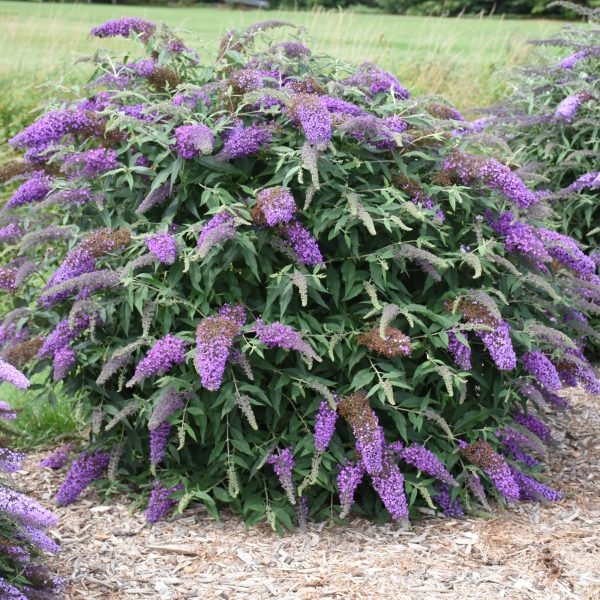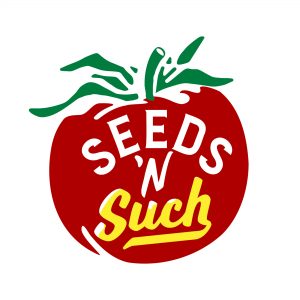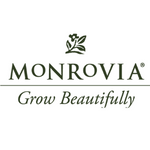Given the moniker of Butterfly Bush, it is expected that this plant would attract some butterflies to the garden. Yet, that is a drastic understatement. Buddleias are, in fact, butterfly MAGNETS, drawing a wide range of butterfly and other pollinator species to them with their plethora of sweet-smelling flowers. So much so, that many butterfly gardens are designed around Buddleia as the core element to support these beautiful creatures. In peak bloom Butterfly Bush can become a joyous source of entertainment — transforming the shrub into a mesmerizing real-life GIF animation while the pollinators move from one nectar-rich flower to the next.
Overview and History
Buddleia has a history as a symbol of resurrection, rebirth, and new beginnings. Sporting a lesser-known nickname of “bombsite bush,” this amazing plant is known for thriving in the toughest environments — even in the rubble of war-torn lands. In post-World War II Europe, Buddleia was known for springing to life from amidst debris, offering communities a sign of hope.
It was Swedish botanist and taxonomist Carl Linnaeus who named this species after Adam Buddle, an 18th-century English botanist. Buddleia plants are endemic to Asia, Africa, and the Americas and are available in over 140 species. Most are shrubs growing to less than 16 ft. tall, but some species qualify as trees. The flower forms of Buddleia are different across species from various continents. Most produce panicles consisting of many individual tubular flowers for easy nectar access for beneficial insects and birds.
“Buddleja” is the original spelling bestowed by Linnaeus, but by the modern practice of botanical Latin, the spelling should have been Buddleia. This alternative spelling has gained widespread acceptance over time and now both spellings are commonly used. Yet some people are firmly rooted in one spelling over the other, which can spark some debates. So, are you Team Buddleia or Team Buddleja?
New Buddleia Breeding to the Rescue!
You may have heard about certain states declaring straight species of Buddleia as invasive. The news might have left you wondering about the fate of these beautiful butterfly-attracting plants in your garden. Well, here’s some reassuring information. While a few state agencies classify Buddleia as a noxious or designated weed, the use of Buddleia isn’t restricted in many states, and the options available to you depends on your location. Keep in mind, “Right plant, right place!”
One proactive way to manage reseeding and encourage your Buddleia to thrive is through a practice known as deadheading. While this technique helps prevent unwanted self-seeding, it also stimulates the growth of new blossoms. Additionally, the good news is that the invasiveness of Butterfly bushes varies by region. In colder climates, typically designated as zone 5 or lower, the harsh winter freezes can effectively destroy the viability of seeds, reducing their spread.
Furthermore, there’s a bright spot for gardeners seeking to enjoy Buddleia without ecological concerns. Newer breeding efforts have resulted in inter-specific hybrids that don’t face the same restrictions as straight species face in some states. These hybrids can be sold in those restricted states if they have been demonstrated to produce less than 2% viable seed. This is often referred to as ‘Low seed set,’ so you can still welcome the beauty of Buddleia into your garden responsibly.
To get the most up-to-date information on the status of Buddleia in your state, we suggest these two resources:
- This link for the USDA Plant database, then click on your state in the left hand column. The states shaded in blue simply indicates states where the Plant Database has identified Buddleia as being established in the landscape. This is common for any non-native plant species and does not indicate invasiveness.
- This map from Invasives.org showing the states that have it listed, banned or not. As of this writing there are a total of nine states that fall in the listed or banned categories.
Given the fairly broad distribution of Buddleia in North America and the limited number of states that have declared it invasive, indicates that Buddleia remain an excellent landscape plant and pollinator.
Buddleia Varieties
Baby Buzz® Candy Pink – A new hybrid with a cascading habit in warm pink tones. Marketed as deer resistant and notably the first hanging basket Buddleia. Hardy to zone 5.
Butterfly Candy – A series of compact, well-branched and floriferous Buddleia which comes in multiple colors (Lil’ Coconut, Lil’ Grape, Lil’ Lavender, Lil’ Raspberry, and Lil’ Taffy) that are ideal for small gardens or containers.
Butterfly Gold – Yellow to white and green variegated foliage helps this plant stand out even before it blooms. Hardy in zones 6a – 9b.
Cascade Collection – ‘Violet Cascade,’ ‘Grand Cascade,’ ‘Lilac Cascade,’ and ‘Pink Cascade II’ are larger landscape plants with graceful cascading flowers that make a lovely backdrop in garden designs. Trialed for four years with no observed seed set. Hardy in zone 5 – 10.
Chrysalis™ series – This low seed set series is notable for its reliably compact habit with an excellent mounding habit. Can be used in hanging baskets, window boxes, or patio container combinations. Hardy in zone 5a – 9a.
CranRazz™ and RoyalRazz® – Both of these hybrid buddleias have excellent upright habits with impressive 8-in. panicles in dramatic, vibrant colors of cranberry red and bright purple. Hardy in zone 5 – 10.
Gold Drop – Part of the HUMDINGER® collection, Gold Drop has unique gold foliage, a selection that draws attention with or without flowers. Hardy in zones 5 – 10.
Flutterby Petite® – A compact plant with a mounding, spreading habit. The fuzzy, silvery green foliage accents the vibrant, blue or pink flowers. Hardy in zones 5 – 10.
Lo & Behold® series – These non-invasive butterfly bushes come in a multitude of colors and sizes: LO & BEHOLD® ‘Blue Chip Jr.’, LO & BEHOLD® ‘Pink Micro Chip’, LO & BEHOLD® ‘Purple haze’, and LO & BEHOLD RUBY CHIP® Buddleias. Hardy in zones 5 – 9.
Miss series – This award-winning non-invasive Buddleia series is characterized by flowers with bright, saturated color on useful medium sized habits. Series includes ‘Miss Molly’, ‘Miss Ruby’ and ‘Miss Violet’. Hardy in zones 5 – 9.
PUGSTER® series – Dwarf butterfly bushes with full sized flowers! Look for PUGSTER® Amethyst, PUGSTER BLUE®, PUGSTER PINKER® and PUGSTER WHITE® Buddleias. Hardy in zones 5 – 9.
Sparkler Petite® – A compact beauty that comes in both pink and purple and is perfect for small spaces growing just 3-4 feet tall and wide. Hardy in zones 5 -10.
How to Grow Buddleia in the Garden
- Full sun exposure is required – 8 hours is best, but not less than 6 hours of direct sun.
- Place plants in a location that gets excellent soil drainage; Buddleia are sensitive to root rot, and standing water can set back growth or cause the plant to expire.
- If you have clay soil, one tip is to plant your Buddleia shrub slightly higher than the ground in a shallower hole. This will create a hill where water and moisture can fall away from the plant rather than settle.
- Because of its vigorous growth, if left unpruned, Buddleia may only produce blooms in its canopy. This is called “second story” flowers. This means the flowers only appear at the very top of its canopy, and you can only enjoy them from a second-story window. inhibiting your enjoyment of its flower color from the ground.
- To encourage more eye-level flowers, prune your Buddleia in spring after new growth appears. Make cuts just above new leaf buds.
- Be patient, as this may take a few weeks into spring; they can be one of the later plants to produce leaves and flowers.
- Avoid planting in the fall. Buddleia may experience more winter damage, especially in colder climates. The plant is generally hardy in zones 5-9. Planting too late does not give the shrub enough time to develop strong roots and establish winter hardiness.
- Since they frequently die all the way back to the ground in northern winters, it is best to cut back all of the old wood to about 12″ in the spring. Doing so will result in more compact plants. They will quickly grow back to their normal height by fall and will flower just as prolifically in late summer since they bloom on new wood. You may notice that the flowers tend to be longer and deeper colored in cooler weather.
Learn more about Buddleia…
- Taming the Beast: How New Plant Cultivars Combat Invasive Spread by National Garden Bureau
- Bring Butterflies Back to Your Garden by National Garden Bureau
- Butterfly Bush Feature by First Editions
Purchase at NGB Member Online Stores and at Your Local Garden Retailer
The National Garden Bureau recognizes and thanks the human experts at Darwin Perennials, an NGB member, as author and contributor to this fact sheet.
This fact sheet is provided as an educational service of the National Garden Bureau. There are no limitations on the use. Please credit National Garden Bureau, and link to this page, when using all or parts of this article or referencing the Year of the program.
Each state in the U.S. has its own list of invasive species. Before trying a new plant in your garden, refer to the USDA’s National Invasive Species Information website or check with local agencies such as an Extension specialist.
Please consider our NGB member companies as authoritative sources for information. See the NGB Member Directory for details about our members. Shop Our Members for seed and plant sources.
Popular Offers
Natural. Effective. Targeted.
Spray for highly effective organic control of beetles, weevils, and borers without harming bees, butterflies or ladybugs! Target the Pest, Not the Rest!
True Blue Buddleia
The truest blue flowers with silver, green foliage. Strong stems and upright habit that is great for borders, embankments, landscape plantings and mixed containers.

The Year of the Buddleia SlideShare Presentation
The Year of the Buddleia Powerpoint Presentation
The Year of the Buddleia logo
PNG or JPG
Printable version of this Fact Sheet
8″ x 10″ printable sign
“Did You Know” Fun Facts about Buddleia
Buddleia poster download
PNG
































